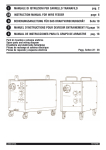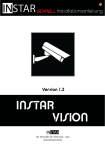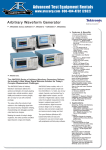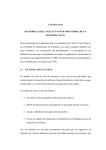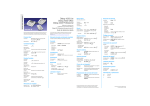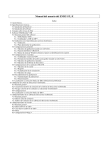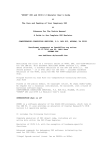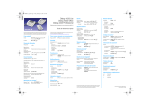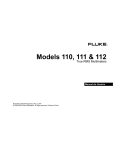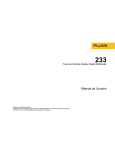Download Installer`s and User`s Manual
Transcript
UO-4S GSM 4-Zone Alarm Panel revision 02 Installer’s and User’s Manual UO-4S GSM 4-ZONE ALARM PANEL Table of Contents 1 GENERAL..................................................................................................6 2 SPECIFICATIONS .....................................................................................7 2.1 2.2 2.3 Alarm Loops .............................................................................................. 7 Relay Outputs............................................................................................ 7 Touch Memory Reader Input ................................................................... 7 3 UO-4S DESIGN..........................................................................................8 3.1 3.2 Panel Light Indicators .............................................................................. 8 Panel PCB and Terminal Blocks.............................................................. 8 4 TECHNICAL DESCRIPTION ...................................................................11 4.1 UO-4S Functional Diagram .................................................................... 11 4.2 Zones to Be Monitored and Alarm Loops ............................................ 11 4.2.1 Loop Type ........................................................................................ 12 4.2.2 Physical Condition............................................................................ 12 4.2.3 Loop Logic Status Control................................................................ 13 4.2.4 Loop Autoarming .............................................................................. 13 4.2.5 Local Arming and Disarming by TM Keys ........................................ 13 4.3 Relay Outputs.......................................................................................... 14 4.3.1 Siren Relay....................................................................................... 14 4.3.2 Lock Control Relay Program ............................................................ 14 4.3.3 Confirmation Relay Program............................................................ 14 4.3.4 Lamp Relay Program ....................................................................... 15 4.3.5 Remote Control Relay Program ....................................................... 15 4.3.6 Switch Off After Loop Disarming Relay Program ............................. 15 4.4 Patrol Check Circuit................................................................................ 15 4.5 Power Control ......................................................................................... 16 4.6 Panel Operating Modes .......................................................................... 16 4.6.1 Operating Mode................................................................................ 16 4.6.2 Fire / Alarm Mode............................................................................. 16 4.6.3 Lock Control Mode ........................................................................... 16 4.6.4 Key Programming Modes................................................................. 17 4.7 Remote Notification ................................................................................ 17 4.7.1 Notification by SMS-messages ........................................................ 17 4.7.2 Notification by Voice Messages ....................................................... 19 4.7.3 Notification by Contact ID Messages ............................................... 20 4.7.4 Notification by Phone Calls .............................................................. 21 4.8 Remote Control ....................................................................................... 21 5 DELIVERY SET, MARKING AND PACKING ..........................................22 5.1 5.2 5.3 Delivery Set ............................................................................................. 22 Marking .................................................................................................... 22 Packing .................................................................................................... 22 6 GETTING STARTED ...............................................................................23 6.1 6.2 6.3 2 Panel Mounting ....................................................................................... 23 TM Reader Connecting........................................................................... 23 Alarm Loops Connecting ....................................................................... 23 UO-4S GENERAL 6.4 6.5 6.6 6.7 Executive Devices Connecting.............................................................. 24 Patrol Check Circuit Connecting ........................................................... 24 Power Supply Connecting...................................................................... 24 SIM-Card Installing.................................................................................. 24 7 UO-4S CONFIGURING ........................................................................... 25 7.1 UO-4S Configuring by Means of PC ...................................................... 25 7.1.1.1 7.1.1.2 7.1.1.3 7.1.1.4 UO-4S Parameters Adjusting .......................................................... 26 GSM-Supervisor Parameters Adjusting ........................................... 27 Notification Filter Adjusting .............................................................. 29 TM Key Parameter Adjusting ........................................................... 29 7.2 UO-4S Configuring by Means of a Cellular Phone............................... 30 7.2.1 UO-4S Parameters Adjusting ........................................................... 31 7.2.2 Remote Control Password Adjusting................................................ 32 7.2.3 Supervisors Descriptors Adjusting ................................................... 32 7.2.4 Loop Assignment Adjusting.............................................................. 34 7.2.5 Autoarming Adjusting ....................................................................... 34 7.2.6 Siren Operating Time Adjusting ....................................................... 35 7.2.7 Inner Sounder Operating Time Adjusting ......................................... 35 7.2.8 Configuration Overwriting................................................................. 35 7.3 Panel Current Time Setting .................................................................... 36 7.4 TM Key Hard Programming.................................................................... 36 7.4.1 TM Master Key Hard Programming.................................................. 36 7.4.2 TM Key Hard Programming.............................................................. 36 7.4.3 TM Key Hard Deleting ...................................................................... 37 8 OPERATING ........................................................................................... 38 8.1 Panel Indication....................................................................................... 38 8.2 Local Arming and Disarming ................................................................. 41 8.2.1 Zone Local Arming by means of ТМ key.......................................... 41 8.2.2 Zone Local Disarming by means of ТМ key ..................................... 41 8.3 Electromagnetic Lock Control ............................................................... 42 8.4 Voice Notification.................................................................................... 42 8.5 Phone Call Notification........................................................................... 42 8.6 Remote UO-4S Panel Control................................................................. 42 8.6.1 Request for current loop logic statuses ............................................ 42 8.6.2 Remote Alarm Loop Arming ............................................................. 43 8.6.3 Remote Alarm Loop Disarming ........................................................ 43 8.6.4 Remote Relay Control ...................................................................... 43 8.6.4.1 8.6.4.2 8.6.5 8.6.6 To Switch the Relay On ................................................................... 44 To Switch the Relay Off ................................................................... 44 Confirmation Sending ....................................................................... 44 Remote UO-4S Time Setting............................................................ 44 9 TROUBLESHOOTING............................................................................ 45 10 MAINTENANCE...................................................................................... 46 10.1 UO-4S Technical Testing Algorithm...................................................... 46 11 MANUFACTURER DATA ....................................................................... 49 Warranty ..................................................................................................... 50 3 UO-4S GENERAL This Installer’s and User’s Manual is intended to help for studying of operability principles and maintenance of UO-4S GSM 4-Zone Alarm Panel revision 02 version 2.14. The UO-4S version number is represented on the label on the device bottom or on the device PCB. Please read these instructions completely before connecting, operating, adjusting, or maintaining this product. 5 UO-4S GSM 4-ZONE ALARM PANEL 1 GENERAL UO-4S GSM 4-Zone Alarm Panel revision 02 (hereinafter referred to as panel) is a control and indicating equipment designed to be the basic element of a fire&burglary system suitable for security providing of various assets such as houses, shops, offices, enterprises and so on. The UO-4S panel main functions are: 1. User programmable monitoring of up to four different zones in order to detect fires, intrusions, breaking, and opening or closing of doors, windows, safes and so on. 2. Internal and external sound and light alarm in case of connected detectors having actuated. 3. Two executive device automated control in accordance with one of the five available programs (external indication, confirmation sending, lock control, and remote control). 4. Remote alarm and service notification and remote relay control by up to five authorized supervisors through GSM 900/1800 cellular communication channel. The way of notification is user programmable and can be one of SMS messages, voice messages, Contact ID DTMF-signals (via corresponding modem), or phone call without reply (if user cell phone is equipped with Caller ID option). The UO-4S panel is also designed to be used within centralized security system monitoring a group of assets from Central Guard Station. In such a case the UO-4S panel is suitable to transmit alarm and service messages from assets to the Central Station, to verify centralized arming, and to be used for scheduled patrol inspecting. In order to monitor fire and intrusion conditions any detectors with dry contact outputs can be connected to the panel, among them magnetic contacts, photoelectric, ultrasonic, RF, acoustic detectors with selfcontained power supply, fire heat detectors, and output circuits of other control and indicating equipment. System arming and disarming can be carried out by several ways. For local authorized arming/disarming by means of Dallas Touch Memory keys an external TM reader should be connected to the UO-4S panel. The UO-4S panel can be used to implement some home automation function such as remote switching on of home electric equipment (light fixtures, locks, air conditioners, kettles, washing machines and so on). UO-4S is to be powered by 12 VDC supply. If RIP-12 uninterrupted power supply manufactured by Bolid Company is in use, UO-4S panel is capable to detect AC line failures following by transmitting trouble notifications to authorized cell phone. UO-4S panel is round-the-clock indoor operable. 6 UO-4S SPECIFICATIONS 2 SPECIFICATIONS UO-4S panel rev.02 is designed to be powered by 12 VDC supply, the panel voltage consumption being from 10.2 to 15 V. The operating temperature range is from −30 to +50°С. The current rating doesn’t exceed 80 mA. When transmitting messages and while registration in GSM-network current consumption can short-time increase up to 500 mA. 2.1 Alarm Loops The maximum number of alarm loops with monitored detectors to be connected to the panel is four. The input alarm loop voltage ranges from 6 to 12 V. When short circuit failure has happened in any alarm loop other loops are kept being supplied as described above. UO-4S restricts the electric current flowing through an alarm loop not to exceed 12 mA. If intruder detectors are included in an alarm loop then wire resistance (without regard to termination resistor) must not exceed 1 kΩ, while leakage resistance between loop wires or between each wire and the earth must be at least 20 kΩ. If fire heat detectors are included in alarm loop then wire resistance (without regard to termination resistor) must not exceed 100 Ω, while leakage resistance between loop wires or between each wire and the earth must be at least 50 kΩ. 2.2 Relay Outputs The device is equipped with three executive relays, one relay being strictly designed to connect a siren. The maximum relay direct switching current is 1 A, while the maximum alternating one is 0.5 А. The maximum relay switching voltage is 24 V for direct current and 100 V for alternating current. The maximum relay switching power doesn’t exceed 10 W. 2.3 Touch Memory Reader Input UO-4S panel is equipped with input contacts to connect an identifier reader circuit. No more than four Touch Memory contact devices can be brought in parallel across identifier reader circuit contacts. There is only one contact terminal to connect external reader LED. The overall length of reader connecting wires must not exceed 100 m provided wire diameter is no less than 0.5 mm. The UO-4S storage memory capacity is 16 TM identifiers. 7 UO-4S GSM 4-ZONE ALARM PANEL 3 UO-4S DESIGN UO-4S GSM 4-Zone Alarm Panel is implemented in plastic case whose view along with overall and mounting dimensions are demonstrated in Figure 3-1. 80 GSM READY ∅7 2 3,5 3 70 103 1 4 Two holes ∅3 135 35 150 Figure 3-1: UO-4S Overall and Mounting Dimensions 3.1 Panel Light Indicators There are six LED indicators on the panel top cover, the upper LED indicating GSM-connection status, next READY LED indicating the panel itself conditions, and rest four LEDs indicating statuses of four connected alarm loops respectively. 3.2 Panel PCB and Terminal Blocks Within panel case the device PCB is housed, with board layout being showed in Figure 3-2. The main components shown are: − the GSM-module with the built-in internal antenna and SIM-card reader, − the internal sounder, − the port for UO-4S to PC connecting, − the tamper switch for unauthorized tampering detecting, and − the group of screw clamp terminals for input and output circuit connecting as follows. 8 UO-4S UO-4S DESIGN To PC COM port for configuring GSM Module External Touch Memory Reader SIM-Card Reader 4 Internal Antenna 1 2 3 GSM READY The Jumper should be set on while PC configuring and operating To External Antenna SIM-Card LED 0B 25 24 TM 23 K3 22 K3 K2 K2 K1 21 20 19 18 К1 17 ШС4ШС4+ 16 15 8.2 kOhm ШС3- 14 8.2 kOhm ШС3+ ШС2ШС2ШС2+ 13 12 ШС1ШС1+ 10 9 8 0B КЦН 0B Кпит. B A Tamper Switch r To Siren To executive Devices 10 kOhm Intruder Loop Auxiliary Loop 11 0B 7 6 5 4 3 2 12B 1 The example of fire heat detector connection 8.2 kOhm Intruder Loop To Patrol Check Circuit To +OC RIP Output To 12V Power Supply Figure 3-2: UO-4S Panel PCB Layout 9 UO-4S GSM 4-ZONE ALARM PANEL PCB Designator LED 0В ТМ К3 К3 К2 К2 К1 К1 ШС4ШС4+ ШС3ШС3+ ШС2ШС2+ ШС1ШС1+ 0В КЦН 0В Кпит В А 0В 12В 10 25 24 23 22 21 20 19 18 17 16 15 14 13 12 11 10 9 8 7 6 5 4 3 2 1 Assignment To connect a TM reader circuit as shown in Figure 3-2 To connect a siren To connect an executive device #2 To connect an executive device #1 Negative and positive contacts to connect an alarm loop #4 Negative and positive contacts to connect an alarm loop #3 Negative and positive contacts to connect an alarm loop #2 Negative and positive contacts to connect an alarm loop #1 To connect a Patrol Check circuit To connect “Кпит” and “0В” UO-4S contacts to “+OC” and “0 V” RIP-12 output contacts respectively Reserved 0 V and 12 V contacts to connect power supply UO-4S TECHNICAL DESCRIPTION 4 4.1 TECHNICAL DESCRIPTION UO-4S Functional Diagram The main functional nodes of UO-4S GSM 4-Zone Alarm Panel and interconnection between them are shown in Figure 4-1. Microprocessor supervises all system components by monitoring for alarm loops, receiving and sending communication data through GSMmodule, and controlling the internal sounder, siren, relay outputs, and Touch Memory reader operations. 12V Power Voltage Converter Indicators 3.6 V GSM READY 1 2 3 4 To GSM Indicator Internal Antenna or External Antenna with Adaptor Alarm Loops Loop 1 Loop 2 GSM-Module Loop3 Loop 4 Microprocessor Relay 1 Relay 2 Siren External Indicator Touch Memory Reader SIM-Card Reader Figure 4-1: UO-4S Functional Diagram 4.2 Zones to Be Monitored and Alarm Loops UO-4S GSM 4-Zone Alarm Panel is designed to monitor up to four different zones for fire or intruder conditions within protected area. Zone is physically represented by an alarm loop with various detecting devices included. 11 UO-4S GSM 4-ZONE ALARM PANEL UO-4S panel allows programming of various zone monitoring methods by means of corresponding alarm loop’s Loop Type parameter configuring and all possible logic status (arming or disarming) controls defining. 4.2.1 Loop Types Depending on detecting devices included and users’ functional needs Loop Type parameter should be defined as one of the following values: Fire (De Incendio): Such a loop is armed without delay and never disarmed. Only heat fire detectors can be brought in such a loop. Entry (Entrada): Such a loop is armed and disarmed after a time delay having expired (that is, entry delay and exit delay can be given for this type of alarm loop). Intruder (De Guardia): Such a loop is armed or disarmed instantly without any time delay. Alarm (Alarmada): Such a loop is armed without delay but never disarmed. Entry, Intruder, and Alarm typed loops can comprise any loopunpowered dry contact output devices such as magnetic contacts, intruder detectors or even control and indication equipment outputs (for example, for smoke detector monitoring if necessary). Auxiliary (Tecnológica): Such a loop is used to enable other loops manual local arming control by any included switch opening (for arming) and closing (for disarming). If only authorized control is assumed then a crypto device can be used for such switching, otherwise a holding key or lock button can be included into alarm loop. 4.2.2 Physical Condition Detecting device monitoring results in loop physical condition defining and report message generating. Fire alarm loop physical conditions are defined depending on its resistance measured as follows: 0.2 Short Failure 0.5 1.6 Breaking 2 kΩ 14kΩ Norm 17kΩ 50kΩ Breaking Open Failure When a fire alarm loop has been broken (fire heat detector has actuated) FIRE (INCENDIO) message is generated. If short or open failure has occurred in a fire loop then TROUBLE message (ROTURA DE LA LÌNEA DE INCENDO) is formed. After fire loop having been restored ARMED (ARMADO) message is generated. Entry, Alarm, and Intruder alarm loop physical conditions are defined depending on its resistance measured as follows: 12 UO-4S TECHNICAL DESCRIPTION Norm – Loop resistance is within 2 to 14 kΩ range and resistance deviations don’t exceed 10% within a hour Breaking – Loop resistance is less than 1.6 kΩ, or more than 17 kΩ, or loop resistance value has jumped (more than 10% of deviation) When an Intruder or Alarm loop has been broken ALARM (ALARMA) message is formed. When an Entry alarm loop has been broken after entry or exit delay expiring ENTRY ALARM (ALARMA DE LA ZONA ENTRANTE) message is generated. Auxiliary alarm loop physical conditions are not defined, with loop opening leading to arming and loop closing leading to disarming of assigned alarm loop. 4.2.3 Loop Logic Status Control An alarm loop can get one of the three logical statuses, which are Armed, Disarmed, and Arming Failed. The panel switches an alarm loop between Armed and Disarmed statuses by four possible configurable ways: – By autoarming with programmable time delay (see clause 4.2.4) – By auxiliary loop closing or opening (see clause 4.2.1) – Local control by means of TM key to reader touching (see clause 4.2.5) – Password protected remote SMS-control (see section 8.2) If physical condition of a loop is Norm during arming, that is its resistance is within normal range, this loop enters Armed logic status. Otherwise, this one enters Arming Failed status. Loop disarming always results in Disarmed status entering. Entry alarm loop enters Armed status after given time (that is exit delay) since TM key to reader touching if its resistance is within normal range. 4.2.4 Loop Autoarming All alarm loops except Fire one can be automatically armed since specified time interval after breaking and recovering if this loop has not been disarmed all this time. For Entry loop the autoarming interval must exceed exit and entry delays. 4.2.5 Local Arming and Disarming by TM Keys The panel provides the connection of the reader of electronic identifiers formatted as Dallas Touch Memory. The user identification is performed by key code reading. 13 UO-4S GSM 4-ZONE ALARM PANEL The reading and writing of a code is realized by means of touching the reader with the electronic identifier. The panel is supplied by single input for reader connection. The distance between the panel and the reader cannot exceed 100 m provided the wire cross-section area is not less than 0,1 square mm. The codes memory capacity is 16 including Master Key identifier. UO-4S alarm loops either by one or by a group can be armed and disarmed by means of TM key to reader touching. The corresponding authorities are established during key programming as discussed in chapter 7. The specific procedures are described in section 8.2. 4.3 Relay Outputs UO-4S panel is equipped with three relay outputs, with relay “K3” being designed as siren and two other ones being user programmable in according with five available programs described below. The relay outputs in question are low-powered (see specification in 2.2 section), so it can be required to include devices with higher commuting parameters in relay circuit. 4.3.1 Siren Relay Relay output #3 (“K3”) is designed to connect a siren. This relay is to be switched on for a given time when an assigned alarm loop has been broken. The operating period and loop coupling are specified during UO-4S configuring. The period can be given so as the siren will not be switched off until assigned alarm loop is disarmed. 4.3.2 Lock Control Relay Program Lock Control program allows assigning a relay only with one panel alarm loop. When the assigned alarm loop has been disarmed or short failed in disarmed condition the relay is switched on for 4 seconds enabling the electromagnet lock opening. Then the relay switches off and the lock is closed. An exit button can be brought in such a relay circuit. 4.3.3 Confirmation Relay Program This type of relay control is suitable for centralized security system. Such a relay is switched when a user is arming assigned alarm loops by means of TM key. Being turned on, the relay switches in interrupted mode 14 UO-4S TECHNICAL DESCRIPTION once per a second. The external light can be included in the relay circuit to indicate the relay switching. The relay is switched off after remote confirmation from Security Station having been received, or when all assigned loops are disarmed, or at least one assigned loop has entered in Fire / Alarm condition. 4.3.4 Lamp Relay Program Such a relay is designed for external indicating. The relay is switched on when at least one assigned alarm loop is armed and there are no assigned loops in Arming Failed status or Breaking condition. If all assigned alarm loops are disarmed the relay is switched off. If at least one assigned loop is in Arming Failed status or Breaking physical condition the relay switches in interrupted mode once per a second. 4.3.5 Remote Control Relay Program This type of relay control is design to enable remote control of various devices connected to this relay circuit, such as electromagnetic lock, electric kettle, conditioner, radiator, washing machine, video camera and so on, provided they are connected through more powerful commuting devices. 4.3.6 Switch Off After Loop Disarming Relay Program This type of relay program is also designed for external indicating. Such a relay can be assigned only with single alarm loop. The relay is switched on when assigned alarm loop is armed. When the alarm loop has been disarmed the relay is switched off. 4.4 Patrol Check Circuit If UO-4S alarm panel is used for centralized safeguard the Control Check facility can be used in order to implement scheduled inspection of assets being protecting. A Patrol Check circuit with sealed contact shunted by 1 kΩ resistor and external LED indicator in series included is connected to the corresponding panel contact terminals (see section 6.5). When a patrol has inspected an asset being protected the magnet is touched to sealed contact, with corresponding signal being transmitted to the Central Guard Station. This signal can designate the inspection having been successful, or can be used to verify the inspection implementation. 15 UO-4S GSM 4-ZONE ALARM PANEL 4.5 Power Control If the UO-4S panel is powered by RIP-12 uninterrupted power supply manufactured by Bolid Company it can monitor the AC line functionality and indicate failing or recovering of mains power line locally and remotely. To enable this option connect “Кпит” and “0 В” panel PCB contact terminals (see Figure 3-2) to “+OC” and “0 V” RIP-12 output contacts respectively. When mains power has dropped such a power control circuit is closed providing power trouble detecting. Similarly, when AC line has restored the power control circuit is recovered too. Moreover, the panel itself detects failures of a 12 V power supply and enables internal indicating and remote notification of supply voltage being out of range. 4.6 Panel Operating Modes UO-4S GSM 4-Zone Alarm Panel operates in one of the following modes: − Operating − Fire / Alarm − Lock Control − Key Programming 4.6.1 Operating Mode The panel mode is considered to be Operating if all armed loop physical conditions are Norm (see section 4.2.2), or if any alarm loop has been open or closed for no more than 250 ms. 4.6.2 Fire / Alarm Mode The panel enters Fire / Alarm mode while any armed loop (except auxiliary) has been broken for more than 300 ms meaning an included detector having actuated. Entry alarm loop enters Alarm condition since entry delay time having elapsed if it was not disarmed during this time. If an actuated loop was assigned with the panel relay “K3”, and an external siren is connected to the relay output in question then such the siren shall be turned on in Fire / Alarm mode. If a relay output is configured as Confirmation (see section 4.3.3) it is switches off in Fire / Alarm mode until broken loop rearming. 4.6.3 Lock Control Mode UO-4S panel provides control of an electromagnet lock connected to a Lock Control programmed relay output. While disarming the loop assigned with this relay, or while pressing on Exit button included in this 16 UO-4S TECHNICAL DESCRIPTION loop being disarmed, the relay turns on for 4 seconds allowing the lock to be released. 4.6.4 Key Programming Modes The panel can be switched in two special modes those are: − TM Master Key Programming mode designed to program special Master TM Key used to enter and exit Key Programming mode by touching TM reader, and − TM Key Programming mode designed to program by hardware a number of TM keys used to arm and disarm a system The panel is switched to these modes as described in section 7.4. 4.7 Remote Notification The UO-4S panel provides alarm and trouble remote GSMnotifications by means of four different ways which are SMS, voice messages, Contact ID DTMF-signals (via special modem), and phone calls without replying (if user cell phone is equipped with Caller ID option). Up to 5 system owners (or supervisors) can be notified by a panel. A panel can be configured to send automatically periodical reports about loops armed currently to one of two pointed supervisors. The types of notifications being sent to panel supervisors can be flexible selected from a group of available ones for each alarm loop and each supervisor separately. 4.7.1 Notification by SMS-messages In Table 1 following is the list of all available alarm and system notifications that can be transmitted (if configured) from UO-4S to an authorized cell phone as SMS-messages. Table 1: SMS messages transmitted by UO-4S Text of SMS-message Received DESARMADO S1 nombre1, S2 nombre2… - USUARIO NN nombre ARMADO S1 nombre1, S2 nombre2… - USUARIO NN nombre FALLO S1 nombre1, S2 nombre2… ROTURA S1 nombre1, S2 nombre2… INCENDIO S1 nombre1, S2 nombre2… Notification Loops with numbers S1, S2, …and with names specified by “nombres” have been disarmed by authorized user (see notes 1-3 below) Loops with numbers S1, S2, …and with names specified by “nombres” have been armed by authorized user (see note 1-3 below) The prompt to arm specified loops has failed Short or open failure of specified loops FIRE at Fire alarm loops with specified numbers and names 17 UO-4S GSM 4-ZONE ALARM PANEL ALARMA S1 nombre1, S2 nombre2… PANICO S1 nombre1, S2 nombre2… DENEGADO PROG PRUEBA ESTADO ARMADO S1, S2… ESTADO: ARMADO S1, S2…, or DESARMADO CONFIRMADO… DC BAJA DC ALTA DC RECUPERADA AC BAJA AC RECUPERADA ALARMA de ENTRADA S1 nombre1, S2 nombre2… APERTURA CERRADO REINICIO 1 2 3 4 18 Breaking of Intruder alarm loops with specified numbers and names Breaking of Alarm loops with specified numbers and names The unregistered TM key has been presented The panel has entered Key Programming mode TEST message, that is periodical automatic report about current loop logic statuses The reply after remote loop status request (see 8.6.1). Can be the list of armed loop numbers (if any), or message about all loops being disarmed Patrol Check circuit is activated DC voltage is below 11 V DC voltage is above 16 V DC voltage has been within normal range AC voltage has been out of range more than 20s AC voltage has been OK more than 20s Breaking of armed Entry alarm loop The panel enclosure has been opened The panel enclosure has been closed The panel has just been restarted Notes: If NN = 1 ÷ 15 then a loop was disarmed/armed by means of TM key with NN number; if NN = 20 then a loop was disarmed/armed by means of auxiliary loop closing/opening; if NN = 21 ÷ 25 then a loop was disarmed/armed remotely by means of supervisor described with (NN − 20) number in panel configuration (see section 7.1.1.2). If NN = 1 ÷ 15 then a loop was disarmed/armed by means of TM key with a configured key name; if NN = 20 then a name field will be empty; if NN = 21 ÷ 25 then name field will contain the name of a supervisor as it was assigned while being configured (see section 7.1.1.2). When Fire loop has been recovering the “USARIO” part is not transmitted. Each notification is preceded by current time formatted as HH:MM (hours and minutes). This timestamp to be displayed correctly set the panel current time remotely as described in section 7.3. UO-4S TECHNICAL DESCRIPTION 5 Each SMS message is preceded by panel name as it was typed while being configured (see section 7.1.1.1). 6 If there are some notification collected in the panel nonvolatile memory they are transmitted by group all together. Up to 16 SMS notifications can be storied in panel memory. 4.7.2 Notification by Voice Messages Following is the list of synthesized voice messages that can be transmitted by UO-4S panel to an authorized cell phone. All voice messages listed below begin with “Atención, es el mensaje del dispositivo número NNNN”, where NNNN is four-digital number of UO-4S in question entered upon configuring (see 7.1.1.1 section). A voice message is considered to have been delivered if it was listened entirely including the number of repetitions given in panel configuration. If the message was not fully listened the panel will attempt to connect with the cell phone to send message for given time of transmission attempts (see 7.1.1.2 section of this manual). Table 2: Synthesized Voice Messages Transmitted by UO-4S Voice Message Received Notification Está desarmada la zona número The zone (alarm loop) with specified <Nº de la zona> por el usuario number has been disarmed by user with specified number <Nº de usuario> Está armada la zona número The zone (alarm loop) with specified <Nº de la zona> por el usuario <Nº number has been armed by user with specified number de usuario> Rotura del lazo <Nº del lazo> The specified loop resistance was out of range during arming, or short/open failure has occurred in this loop Incendio en la zona <Nº del lazo> Fire in this zone or Fire loop breaking Alarma en la zona<Nº del lazo> Intruder Alarm in specified zone Atraco en la zona <Nº del lazo> Panic button has been pressed in zone specified, or breaking of Alarm loop La llave no autorizada Unknown TM key has been touched to UO-4S panel reader Programación The panel has just entered TM KEY Programming mode Confirmación de la guardia The Patrol Check circuit has been activated Fallo de alimentación de reserva 12 VDC voltage is out of range between 11 V and 16 V 19 UO-4S GSM 4-ZONE ALARM PANEL Voice Message Received Notification Recuperación de alimentación de 12 VDC voltage has been restored reserva Fallo de alimentación Mains power has failed more than 20 s Recuperación de alimentación Mains power has been restored Alarma de la entrada Breaking of armed Entry alarm loop Alarma de sabotaje The panel enclosure has been opened El sabotaje se ha recuperado The panel enclosure has been closed Reinicio Panel restart 4.7.3 Notification by Contact ID Messages If Contact ID protocol is selected in order to be transmitted through GSM-channel the panel ID must contain only non-zero digits. The receiving GSM signal level should exceed a half of cell phone scale. Table 3: Contact ID Messages Transmitted by UO-4S Contact ID Codes Fourdigital panel number Identifier Qualifier Event Code Loop Number User Number CS Disarmed XXXX 18 1 401 X XX X Armed XXXX 18 3 401 X XX X Arming Failed XXXX 18 1 454 X Fire Loop Trouble XXXX 18 1 373 X 0 X Fire XXXX 18 1 110 X 0 X Intruder Alarm XXXX 18 1 132 X 0 X Panic Alarm XXXX 18 1 122 X 0 X Unknown TM Key XXXX 18 1 406 0 0 X TM-Programming XXXX 18 1 627 0 0 X TEST XXXX 18 1 602 0 0 X Patrol Check XXXX 18 1 999 0 0 X Low 12 V Voltage XXXX 18 1 302 0 0 X High 12 V Voltage XXXX 309 0 0 X 12 V Recovered XXXX 18 3 302 0 0 X AC Failed XXXX 18 1 301 0 0 X Notification 20 X UO-4S TECHNICAL DESCRIPTION Contact ID Codes Fourdigital panel number Identifier Qualifier Event Code Loop Number User Number CS AC Restored XXXX 18 3 301 0 0 X Entry Alarm XXXX 18 1 134 0 0 X Panel Tampering XXXX 18 1 383 0 0 X Panel Case Closed XXXX 18 3 383 0 0 X Panel Restart XXXX 18 1 305 0 0 X Notification 4.7.4 Notification by Phone Calls The notifying by phone calls without replying is the least-cost and least-informative way. It can be configured to mean only one event or event complex. Such a way of notifying is available only if user cell phone is equipped with Caller ID option. The panel is configured to transmit specified reports by Phone Call to pointed supervisor as described in chapter 7. The supervisor enrolls the panel phone number with a text comment as a name into his or her cell phone contact list. When the event programmed has happened the UO-4S panel shall call supervisor phone, with the event description being displayed on the cell phone screen. The user receives the call, the panel discarding the communication immediately resulting in the call to be no paid for. 4.8 Remote Control UO-4S remote control is implemented by means of sending SMSmessage containing a password protected command to UO-4S destination phone number. The command can be fulfilled if only source phone number and the password presented are programmed in UO-4S configuration (see 7.1.1.1 section).The list of remote control operations available for such a phone owner is as follows (see 8.6 section for more details): − Request for current logic statuses of alarm loops (armed or disarmed) − Specified alarm loop arming − Specifies alarm loop disarming − Specified relay switching for given time period − Report Confirmation sending − Time setting 21 UO-4S GSM 4-ZONE ALARM PANEL 5 5.1 DELIVERY SET, MARKING AND PACKING Delivery Set Following is the list of the UO-4S GSM 4-Zone Alarm Panel components being delivered from manufacturer: 9 UO-4S GSM 4-Zone Alarm Panel 9 This Installer’s and User’s Manual 9 3 self-tapping screws 3×25.016 with 6х30 dowels 9 4 loop termination resistors MF 1/2W-8K2-5% 9 UO-4S to PC connecting cable 9 TM-key DS1990R-F5 UO-4S can be supplied with external 900/1800 GSM antenna and GSM to FME adapting cable. 5.2 Marking Each panel is supplied with marking as follows: 9 Manufacturer logotype 9 Symbolic notation 9 The year and the quarter of the manufacturing 9 Accordance mark 9 Factory serial number The external panel terminal marking corresponds to the PCB layout (see 3.2 clause). 5.3 Packing The panel along with component parts and maintenance documentation is packed into the carton box. It is assumed to pack the panel into the proper container. The boxes or containers are placed along with accompanying documents into the transportation packing. Each transportation packing should be furnished by packing list contained information as follows: 1) Manufacturer logotype; 2) The identification, designation and the number of products inside; 3) The designation and the number of replacement components; 4) Packager sign or stamp; 5) The packaging date. 22 UO-4S GETTING STARTED 6 6.1 GETTING STARTED Panel Mounting Do FOLLOW the electrical installation operational and electrical safety code rules during the installation, operation, or maintenance of S2000-ASPT panel and communication lines and associated equipment. Do SHUT OFF mains and backup power before installing the panel or repairing any failure. Prevent the electric wire isolation from being broken at sharp edge rounding places. While removing the panel from its package on receipt inspect the panel PCB to be free from detached components and pinout defects. Test the panel operability in accordance with technical algorithm discussed in section 10.1. The panel is to be mounted on walls or other suitable surfaces protected against atmospheric layouts, mechanical damages and unauthorized access. 6.2 TM Reader Connecting If the panel is to be controlled locally by means of TM keys an external TM reader must be connected as shown in Figure 3-2 and discussed in section 2.3. 6.3 Alarm Loops Connecting Connect all necessary alarm loop circuits to the PCB terminal blocks marked as "ШС" (from #9 to #16). All detectors have to be wired into alarm loop in series with 8.2 kΩ resistances provided as shown in Figure 3-2. Fire heat detectors additionally have to be brought in circuit with 10 kΩ resistance in parallel across it. The possible number of devices to be included into each alarm loop is defined by user needs and technical restrictions for loop and wires resistance (common loop resistance shall be within 2 to 15 kΩ range and common wire resistance shall not exceed 100 Ω for fire loop and 1 kΩ for rest ones). If Exit button is to be brought in a loop circuit it is included as shown in Figure 6-1. 23 UO-4S GSM 4-ZONE ALARM PANEL Figure 6-1: Exit Button Wiring 6.4 Executive Devices Connecting Connect if necessary an external siren to panel К3 contacts (#21 and #22). Connect the required executive devices to the contacts K1 and K2 (#17-#20) in accordance with the connecting diagram shown in Figure 3-2. If the executive devices require more powerful switching equipment include such devices into the relay output executive circuit. 6.5 Patrol Check Circuit Connecting Connect if necessary Patrol Check circuit as shown in Figure 6-2. Figure 6-2: Patrol Check Circuit Wiring 6.6 Power Supply Connecting Connect power supply leads to “12 B” and “0 V” (#1 and #2 respectively) panel PCB contacts (see Figure 3-2). If RIP-12 uninterrupted power supply is to be used connect its +OC contact to the “Кпит” (#5) panel terminal and couple RIP-12 0 V terminal with panel “0 B” contact #6 in order to provide mains power control (see section 4.5). 6.7 SIM-Card Installing In order to communicate with UO-4S panel by means of a GSM channel a cell phone SIM-card must be located into the panel GSM-module (see Figure 3-2). Before installing inside the panel disable PIN-CODE PROMPT SIMcard setting by means of any available cell phone. Verify the sufficiency of GSM-network signal level at the place of panel location. If two-tone Contact ID protocol is assumed to be used in order to transmit notifications the GSM signal level must reach at least a half of the cell phone scale. 24 UO-4S UO-4S CONFIGURING 7 UO-4S CONFIGURING In order to adjust UO-4S panel for particular application it is necessary to describe all its configuration parameters, those fall into three groups, which are: − UO-4S own parameters such as identification name/number (ID), remote control password, loop parameters, entry and exit delays, sounders and relay parameters − System’s owners or supervisors parameters such as phone numbers, ways of notification transmission and their parameters, and types of reports to be transmitted − TM Key parameters The adjusted values of configuration parameters are storied in the panel non-volatile memory. The panel can be configured by several ways. The best way to program the UO-4S panel is to connect it to a computer by means of cable provided and to apply the program UPROG.EXE of version 4.0.0.906 or above. The first and second groups of panel parameters can also be configured through panel’s SIM-card inserted in any available cell phone. TM key parameters can be adjusted by hardware. The panel being configured in any way, the panel top cover is opened. Due to the panel is equipped with a tamper switch; a fact of panel configuring can always be monitored by corresponding notification adjusting. When configuring has been completed take care to close the panel top cover. In order the event time within SMS notifications to be displayed correctly set the proper panel current time by remote SMS-command as explained in section 7.3. 7.1 UO-4S Configuring by Means of PC Adjust UO-4S panel by means of a computer by doing the following. Power on the computer with UPROG.EXE installed. Verify the version of configuration program is 4.0.0.906 or above. Connect UO-4S to a COM port of computer by connecting cable provided. Ensure the panel PCB jumper is set on. Power the UO-4S on and run UPROG.EXE. Click button from the tool bar or select Dispositivo → Leer configuración de dipositivo commands. 25 UO-4S GSM 4-ZONE ALARM PANEL When Búscueda de dispositivos window has been opened, enter (or select) the PC COM port the panel is connected to into Puerto serie field and select Búscueda command. When the list of the devices found at pointed COM port has been displayed, select the UO-4S being configured and click Eligir button. The configuration having been read, the main UPROG window is opened. Once the panel configuring has been completed save all settings by writing new configuration to UO-4S by means of Guardar la configuración en el dispositivo command from the Dispositivo menu or from toolbar. The sound signal will acknowledge the change saving. The configuration having been set can be changed in future if necessary. 7.1.1.1 UO-4S Parameters Adjusting In order to configure UO-4S parameters select Dispositivo tab. First, describe the object setting UO-4S parameters. Enter the unique UO-4S identifier into the ID de instalación field. It can contain from one to seven digits or letters and must not begin with 0. If Contact ID protocol or Vice messages are assumed to be used for notifications transmitting through GSM-channel the panel identifier must be presented by four nonzero digits. Next, type the five-digital password for remote UO-4S control ability into the Contraseca field. If necessary select entry and exit delays from 1 to 255 seconds in Tiempo para entrar and Tiempo para solir fields. By default these values are set to 0, that means no delaying. Then, define each alarm loop settings. For each loop select the suitable loop types (see 4.2.1 clause) from Tipo de Z1-Tipo de Z4 dropdown menus. Set Autoarmar switches on if necessary (see 4.2.4 section). Select the autoarming delay if necessary in Retraso al almar field keeping in mind that autoarming delay for Entry alarm loop should exceed both entry and exit delays set above. The value can range from 0 to 255 seconds. Enter the text names consisting from 1 to 8 symbols for each loop into Nombres de la zonas fields. These names will identify the corresponding alarm loops in SMS messages transmitted by panel while notification. If some of the panel alarm loops are configured as auxiliary (see 4.2.1 clause) mark the alarm loops which must be armed and disarmed after auxiliary loop opening and closing respectively in Armar and Desarmar windows of Tecnológica. 26 UO-4S UO-4S CONFIGURING Next, give the relay parameters in Relé 1-2 sections. Select the required relay types in Tipo and assign each relay with loops (zones) whose breaking has to lead to the relay switching in Zonas. The available relay programs are (see 4.3 clause): Gestión de cerradura - Lock Control Confirmación - Confirmation Làmpara - Lamp Gestión de exterior - Remote Control Apagar al desarmar - Switch Off After Loop Disarming Finally, in Sirena y la biper interior section define the settings of the panel sound alarms if necessary. Enter the siren sounding time from 1 to 255 seconds in Duración de alarma field and assign the siren with alarm loops whose breaking has to be accompanied with external siren signaling in Zonas asociadas con sirena windows. Similarly, enter the internal sound alarm operating time in Tiempo func. de biper field and couple the internal sounder with alarm loops whose breaking has to cause the internal sound signaling in Zonas asociadas con biper windows. Zero set in Duración and Tiempo fields designates not sounding, while value of 255 designates that sounding will not be terminated until the alarm loop will be disarmed. 7.1.1.2 GSM-Supervisor Parameters Adjusting In order to configure supervisor parameters select Teléfonos tab. At the top part of the window having been opened there is a group of transmission parameters set by default. The default values are defined for typical applications in order to keep optimal ratio between delivery reliability and communication expenses. If messages to be transmitted are of great importance for the system owner and must not be lost it is advisable to increase the values of parameters in questions. If Voice messages are selected to be transmitted set the number of transmission attempts in Numero maximo de mensajes en transmission por canal de voz field. By default this value is set to zero, so Voice messages cannot be transmitted. Voice messages are not repeated in one communication session by default, so set the required number of repetitions in Repeticiones de mensajes de voz field if necessary. The field Tiempo de escuche maximo en minutos is reserved. It can be no more than five GSM-supervisors for each UO-4S panel. The GSM-supervisor is considered to be a panel owner with particular cell phone number communicated with panel only by a single way, i.e. by SMSmessages, or by Voice messages, or by Contact ID protocol, or by Phone Call. If a phone owner wishes to receive information from panel by several 27 UO-4S GSM 4-ZONE ALARM PANEL ways he has to be registered in panel configuration several times with the same phone numbers and different notification methods. Define each supervisor descriptor in Teléfono 1 – Teléfono 5 sections. Enter the full cell phone number with international code included in Numero de teléfono field. Then, describe the parameters of TEST notifications. Select the required type in Tipo de aviso TEST dropdown menu. You can choose not being notified, or SMS-notification every several hours, or phone calls every several hours or minutes. Select the proper numerical time value in the window Periodo de transmisión below. Next, choose the communication way in order to transmit alarm and service notifications from UO-4S panel to system owner in question in Protocolo de transmisión de mensajes field. It will be one way from Mensaje SMS, Llamada de voz, Contact ID (ADEMCO) and Llamada telefónica. Notes: Please, keep in mind that 1. Selected types of TEST notification must be in agreement with type of other notifications. If SMS-channel is selected to be transmission way then TEST notification has to be transmitted as SMS too. If all event messages are transmitted via any other channel, TEST notifications are to be typed as phone call. 2. TEST notifications are transmitted ONLY to phone numbers defined in Teléfono 1 OR Teléfono 2 descriptor. 3. TEST notifications are NOT transmitted when all alarm loops are disarmed. 4. Each TEST notification is transmitted when time period designed in Periodo de transmisión field has been expired since any last transmission that is alarm notification, or service notification, or preceding TEST one. If the time pointed is zero then notifications will not be transmitted. 5. Remember that GSM-signal receiving level should be at least a half of telephone scale if Contact ID (ADEMCO) is used. Then, select for each alarm loop in Parametros de transmisión section the way for transmission of notifications specified below in 7.1.1.3 clause. The notifications about each alarm loop conditions can be not transmitted to this supervisor at all, or can be transmitted all, or only alarm messages can be transmitted, or all notifications except DESARMADO or ALARMA. Finally, in Nombre window type the system owner’s name which will be displayed in SMS messages being sent to other supervisors in case of remote arming and disarming. 28 UO-4S UO-4S CONFIGURING The switch Permitir descolgar el teléfono is reserved. 7.1.1.3 Notification Filter Adjusting Adjust the types of messages to be transmitted by UO-4S panel to its supervisors. Select the Filtros de mensajes tab. The table with message list down and supervisor list across will appear. All types of available notifications are described in section 4.7 of this manual. By default each cell in table is marked meaning that all types of notifications are available to transmit to all supervisors. Double click left mouse key on those cells that are located at points of intersection of message that MUST NOT be transmitted and supervisor that MUST NOT be notified by corresponding message. Such the cells will be empty. 7.1.1.4 TM Key Parameter Adjusting Select Llaves tab in order to add or delete TM keys, or to assign them with specified authorities. The tools available at the toolbar will be as follows: - To read keys from a file Leer fichero de los cуdigos de llaves - To write the keys into a file Guardar el fichero de los cуdigos de llaves - To read keys from a device Leer las llaves de dispositivo - To write the keys into the device Guarda las llaves en dispositivo - To add a key Aсadir un llave nueva a dispositivo - To delete the selected key Borrar llave To begin with, it is necessary to read keys from the panel if presented. If there is no key programmed before it is possible to read keys from floppy disk (by means of first tool if such a disk is available) or to program a number of keys manually. TM Master Key can not be created by software. To program it follow the instructions of section 7.4.1. When Master Key has been programmed 29 UO-4S GSM 4-ZONE ALARM PANEL its descriptor is located within Key Table string with zero number on the computer screen. ATTENTION: When TM Master Key has been programmed all TM keys configured before are lost. To add new TM key with arming/disarming authorities: Select Acadir la llave button from the toolbar Select Leer la llave button at right part of the screen and touch a TM key to the reader following in system prompt When the programmed TM key descriptor has appeared within the table select its specified loop arming and disarming authorities by double clicking on table cell located at the intersection of desired operation and specified alarm loop. Type a text name for TM key if necessary. You cannot assign any authority to the Master Key because it is designed to switch the panel into programming mode. When the list of TM keys has been created you can change key authorities as described above or delete any key by means of Borrar llave tool button. You can write all programmed keys into a file of special format to a floppy disk by means of Guardar el fichero de los cуdigos de llaves tool. Such a disk can be used to load all programmed keys into any other UO-4S panel to be controlled by the same TM keys. In order to store key adjustment into panel non-volatile memory select Guarda las llaves en dispositivo tool button. 7.2 UO-4S Configuring by Means of a Cellular Phone Configuring the panel via its SIM-card makes not so much opportunities as programming by means of a PC. The message filters can not be adjusted by means of a cell phone, all available messages being transmitted to all registered supervisors. The TM key codes are not programmable through a SIM-card. In such a case they are to be registered by hardware as shown in section 7.4. Moreover, there is no any feedback when configuring by means of cell phone settings. A mistake within entered command can cause a malfunction of panel operability. So be careful when programming the UO-4S SIM-card manually. 30 UO-4S UO-4S CONFIGURING In order to program UO-4S panel through SIM-card insert the panel’s SIM-card into any available cell phone and select SIM-CARD MEMORY option in phone settings. 7.2.1 UO-4S Parameters Adjusting In order to define the name/number of UO-4S panel itself, the alarm loop types, relay executive programs, entry and exit delays, and the number of attempts of Contact ID message transmission add the following entry to the phone contact list: Name ParNAME Phone Number XXXXYY*Z*T*W where: NAME is a name or number to identify this panel while notification is sent. It can consist from digits and letters, the first symbol being no zero. Its length can range from 1 to 7 symbols. If Contact ID or Voice notification channels are in use the panel name has to contain only digits from 1 to 9 zero excluding. XXXX are types (in accordance with Table 4) of alarm loops from the first to the fourth as they are marked on panel PCB YY are types (in accordance with Table 5) of the first and the second relays Z is an exit time (arming delay) in seconds from 0 to 255, zero meaning arming without delay. By it is set to zero. T is an entry time (disarming delay) in seconds from 0 to 255, zero meaning disarming without delay. By default this one is set to zero. W is a number of attempts of Contact ID message transmissions from 1 to 10 Table 4: Designators of Alarm Loop Types X Loop Type Designation 0 Reserved 1 Entry Zone with arming and disarming delay capabilities 2 Intruder Armed and disarmed without any delay 3 Reserved 4 Alarm Never disarmed 5 Fire Never disarmed 6 Auxiliary For assigned alarm loops arming when opened and disarming when closed without delay 31 UO-4S GSM 4-ZONE ALARM PANEL Table 5: Designators of Relay Types Y Type of Executive Relay Program 0 Lock Control (can be assigned only with single loop) 1 Confirmation 2 Lamp 3 Remote Control 4 Switch Off After Loop Disarming (can be assigned only with single loop) Example: contact entry with Par1111 in Name field and 122223*60*30*3 in Phone number field will be considered as following UO-4S configuration: – This UO-4S panel is identified as 1111 – The first alarm loop is configured to be Entry – The rest alarm loops are configured to be Intruder – The first relay has Lamp type – The second relay can be controlled remotely – The exit time will be 60 sec – The entry time will be 30 sec – The Contact ID messages transmission attempts number is 3. 7.2.2 Remote Control Password Adjusting Set the UO-4S remote control password by adding the following contact entry: Name Pas or Password Phone Number XXXXX where XXXXX is five-digital password. Strictly five digits must be typed as a password, otherwise remote control is disabled. 7.2.3 Supervisors Descriptors Adjusting In order to describe supervisors to control the system remotely, add the following contact entry for each supervisor descriptor (five maximum): Name Phone Number ANXXXXYTZZ PHONE NUMBER where: A is the special initial symbol N is the sequence number of descriptor which can be from 1 to 5. This number must not be repeated from entry to entry XXXX is the sequence of message transmission parameters (see Table 6) for loops from the first to the fourth Y points the way of notification transmission (see Table 7) 32 UO-4S UO-4S CONFIGURING T ZZ points the way of TEST message transmission (see Table 8) defines the time period in corresponding units for TEST message transmission period PHONE NUMBER is supervisor’s cell phone number preceded by international code which notifications will be sent to. Table 6: Message Transmission Parameters Symbol Meaning 0 Don’t transmit notifications concerning this alarm loop 1 Transmit only alarm messages concerning this alarm loop 2 Don’t transmit DESARMADO and ALARMA DE ENTRADA 3 Transmit all messages 4 Transmit all messages except ALARMA DE ENTRADA Table 7: Notification Transmission Ways Symbol Meaning s Notification by SMS messages d Notification by DTMF t Notification by Phone Call g Notification by Voice messages Table 8: TEST Message Transmission Parameters Symbols Meaning s TEST notification is transmitted by SMS every several hours (from 1 to 250 hours) h TEST notification is transmitted by Phone Call every several hours (from 1 to 250 hours) m TEST notification is transmitted by Phone Call every several minutes (from 1 to 250 minutes) 000 Don’t transmit TEST notification Notes: 1. Phone Call and SMS message TEST can be sent only to A1 and A2 supervisors. 2. TEST messages are not transmitted when all alarm loops are disarmed. 3. TEST message sending period is counted from any last transmission to this supervisor. 33 UO-4S GSM 4-ZONE ALARM PANEL 4. There must not be the same Name field in two or more entries. 5. If you desire to receive different kinds of notification at a single cell phone you should record the corresponding number of entries with the same Phone Number field and different Name fields. Example 1: Name A14444ss02 means that the first supervisor will receive SMS messages TEST every 2 hours. Example 2: Name A11234gm10 means that the first supervisor will receive: – Voice alarm messages dealing with the first alarm loop – All Voice messages dealing with the second loop except DESARMADO and ALARMA DE ENTRADA – All Voice messages dealing with the third loop – All Voice messages dealing with the fourth loop except ALARMA DE ENTRADA – TEST messages are transmitted by Phone Call every 10 minutes 7.2.4 Loop Assignment Adjusting In order to assign alarm loop breaking with other panel executive and auxiliary equipment add the following contact entry: Name ShlXXXX Phone Number YYYY0ZZZZ8SSSS9DDDD7BBBB6 where: XXXX are the numbers of alarm loops assigned with relay K1 YYYY are the numbers of alarm loops assigned with relay K2 ZZZZ are the numbers of alarm loops assigned with external siren SSSS are the numbers of alarm loops designed to be armed by auxiliary loop opening DDDD are the numbers of alarm loops designed to be disarmed by auxiliary loop closing BBBB are the numbers of alarm loops assigned with the internal panel sounder The separating characters 0, 8,9,7,6 are mandatory. 7.2.5 Autoarming Adjusting In order to point alarm loops to be automatically armed since several time interval after breaking, add the following entry to the contact list: Name AutoXXXX 34 Phone Number YYY UO-4S UO-4S CONFIGURING where: XXXX is the list of alarm loop numbers to be autoarmed after breaking YYY is the time period ranged from 0 to 255 seconds for arming to be delayed after breaking 7.2.6 Siren Operating Time Adjusting In order to give external siren operating time while associated loops are broken, add the following entry to the contact list: Name Sir Phone Number YYY where: YYY is the number of seconds you want the connected siren to be switched on in case of assigned loop breaking. The time value can range from 0 to 255 seconds, with 0 meaning not sounding and 255 meaning the siren will sound continually until alarm will be reset. By default the siren operating time is set to zero (not sounding). 7.2.7 Inner Sounder Operating Time Adjusting In order to give panel internal sounder operating time while associated loops are broken add the following entry to the contact list: Name Sound Phone Number YYY where: YYY is the number of seconds you want the sounder to be switched on in case of assigned loop breaking. The time value can range from 0 to 255 seconds, with 0 meaning not sounding and 255 meaning the sounder will be switched on continually until alarm will be reset. By default the sounder operating time is set to zero (not sounding). 7.2.8 Configuration Overwriting The configured parameters must be relocated from the SIM-card to the UO-4S non-volatile memory. To do this: 1) Power off the UO-4S panel and open the panel cover 2) Move the SIM-card from the cell phone to the panel SIM-card reader 3) Power up the panel and wait for 10 seconds until READY LED has terminated flashing 35 UO-4S GSM 4-ZONE ALARM PANEL 4) Enter TM Key Programming mode by touching the TM reader with Master Key. The panel internal sounder shall doubly beep three times meaning Programming mode entering 5) Press and hold panel tamper switch for 10 ÷ 15 seconds 6) Wait until UO-4S terminates beeping (less than 1 minute) 7) Replace the panel cover. Note: Write the configuration from SIM-card into the panel memory only if the communication within GSM-network is stable. 7.3 Panel Current Time Setting Set the UO-4S panel current time as described in section 8.6.6. 7.4 TM Key Hard Programming In order to program TM keys by hardware it is necessary to open the panel top cover. After programming completing put the panel cover on. 7.4.1 TM Master Key Hard Programming In order to program TM Master Key by hardware, power the UO-4S panel off and couple TM reader contact terminals. Then, switch on the panel again. Panel to TM Master Key Programming mode entering shall be confirmed by two double short and one long signal of panel internal sounder. Disconnect TM reader contacts and touch the reader by a TM key within 10 seconds after disconnecting. Two short beeps will confirm the new Master Key recording into the panel memory, all information about TM keys programmed before being erased. To exit the TM Master Key Programming mode do one of the following: couple TM reader contacts for 4 seconds, or wait for 30 seconds, or shut off the panel power. 7.4.2 TM Key Hard Programming In order to program TM keys suitable for zone arming/disarming (the maximum number of such the keys is 15) ensure all Intruder and Entry alarms are disarmed. Otherwise the TM Key Programming mode is unavailable. Switch the panel power on and wait for 10 seconds. Touch the Master key to the TM reader. The panel internal sounder will emit three double beeps confirming TM Key programming mode entering. Touch the TM reader by TM key to be programmed. Its code will be recorded into the panel memory, the sounder emitting two beeps. The 36 UO-4S UO-4S CONFIGURING LEDs from 1 to 4 will indicate the number of TM key being programmed for 2 ÷ 3 seconds, then they will begin to display the statuses of assigned alarm loops. Notes: If the TM key presented has already been programmed for this panel then UO-4S acknowledges it by once beep. If the panel key memory is full meaning that 16 key with Master Key included have already been programmed then the panel sounder emits long error signal. If the TM key has been successfully registered by the panel, couple it with alarm loops to be armed and disarmed by this key. Close in turns the corresponding loop contacts for short time. If corresponding LED is lighting it means that this loop is assigned with the key being programmed. In order to confirm programming touch the TM reader by this key once more. Repeat programming for another TM key if necessary or exit TM Key programming mode by closing reader contacts for 4 seconds, or by waiting 30 seconds after any programming operation, or by shutting panel power off. The exit from programming mode will be confirmed by sounder beep. Note: If any alarm loop is closed the panel can’t leave the programming mode. 7.4.3 TM Key Hard Deleting In order to delete the code of a TM key with arming and disarming authorities from the panel memory do the following. Disarm Intruder and Entry alarm loops and enter TM Key Programming mode as described in previous section. Touching the TM reader by TM Master Key, press the panel tamper switch for short time and remove the last one. Press tamper switch such many times as a number of TM Key to be deleted. The LEDs from 1 to 4 will indicate the binary form of TM Key number. Press and hold tamper switch for 5 ÷ 8 seconds. When the key has been deleted the panel will sound. Then delete other key or exit programming mode by TM Master Key to reader touching, or by reader contacts coupling for 3 seconds, or by waiting 30 seconds since the last programming operation. Note: If an attempt of TM Master Key deleting is implemented the panel records parameters into SIM-card and DOES NOT DELETE key with zero number (that is, Master Key). 37 UO-4S GSM 4-ZONE ALARM PANEL 8 OPERATING In this chapter it is shown how to monitor your system statuses and events depending on light and sound indication observed, how to arm and disarm your system, how to receive notifications, and how to implement system remote control. You can change system settings if necessary as shown in chapter 7, or to add/delete TM keys as described in section 7.4. 8.1 Panel Indication The Tables below demonstrate the behavior of panel light and sound indicators depending on conditions or events having occurred. Table 9: GSM LED Indication Condition Indicator Behavior 232-line communication Lit by green or yellow 232-line communication has been lost Switched off or flashes by red The level of GSM signal received is too low or communication has been lost Flashes by red or yellow eight times per a second Too much GSM errors Flashes by red or yellow four times per a second Table 10: READY LED Indication Event, or Condition Indicator Behavior TM key to reader first Three flashes touching in Operating mode LED flashes four times per 2 seconds, 1 ÷ 4 LEDs displaying key number in binary code. TM key to reader touching in Then READY LED flashes once per a second, Key Programming mode 1 ÷ 4 LEDs indicating loops being assigned with this key Key deleting Flashes twice for 2 seconds, 1 ÷ 4 LEDs displaying the number of key being deleted Norm Lit steady GSM-module with panel Sets of four-times flashing twice per a second at communication has been lost 2 second intervals GSM signal has dropped Sets of two-times flashing twice per a second at below normal value 2 second intervals Supply voltage is out of Flashes once per a second; of switches off if 11 V – 15 V range GSM-coupling with panel has been lost too 38 UO-4S OPERATING Table 11: Panel 1-4 LED Indication Condition of a Loop Corresponding Indicator Behavior Loop is disarmed Associated LED is lighted off Loop is armed Associated LED is lighted on Loop is broken, or its arming failed Associated LED flashes twice per a second* The arming command has Flashes twice per a second if loop resistance is been received, but the arming out of normal range; or flashes once per 2 delay has not been expired seconds if not *Note: Such indication is kept within 2 minutes since a broken loop has been disarmed Table 12: External LEDs (TM Reader and Patrol Check Circuit) Indication Event, or Condition Indicator Behavior All loops apart from Alarm Switched off and Fire ones are disarmed At least one loop apart from Switched on if power supply is within normal Alarm and Fire ones are range, or flashes once per two seconds armed otherwise At least one alarm loop has been broken or its arming Flashes twice per second has failed Entry alarm loop is arming, Flashes twice per a second if loop resistance is arming delay having not out of range, or flashes once per two seconds been“ expired otherwise TM Reader Indicator (only) after triple flashings First TM key to reader displays current conditions of loops assigned touching in Operating mode* with this key Disarming Is switching off Arming Is switching on Patrol Check Patrol Check Indicator (only) flashes two times Key Programming mode Switched off Unknown Key TM Reader Indicator (only) switches on for 0.5 s *Note: After single TM key to reader touching the external reader displays the conditions of loops assigned with this key for 30 seconds. To arm or to disarm the assigned zones touch the same key to reader once more within this 30 second period. 39 UO-4S GSM 4-ZONE ALARM PANEL Table 13: Internal Sounder Indication Event, or Condition Sounder Behavior Operating mode Switched off Breaking of an associated loop, or associated loop fire trouble Sounds in interrupted mode Arming of an associated loop Two short beeps Disarming of an associated loop If the sounder was on it is switched off, or emits a beep otherwise Delaying of arming Short beeps once per two seconds. Within 15 sec before arming delay having been expired the beep frequency increase up to twice per a second Illegal TM key to reader touching Long sound Arming of a loop has failed Sounder is off TM Key Programming mode entering Three short double sounds If the key code has already been recorded into UO-4S memory then the sounder emits a beep. TM key to reader touching in Key Programming mode If the TM key been touched is unknown the sounder acknowledges the new key code recording into the UO-4S memory by two beeps. If UO-4S key memory is full and all 16 key codes have already been recorded then the sounder emits long sound signal. It is necessary to delete an existing key in order to program new key Master Key Programming Two short twice beeps and then one long sound mode entering TM key to reader touching in Master Key Programming Two beeps mode TM key deleting 40 One long and two short sounds UO-4S 8.2 OPERATING Local Arming and Disarming Local zone arming and disarming are implemented by three different ways as was discussed in section 4.2, namely by autoarming after breaking, by auxiliary alarm loop assigned with this zone opening and closing respectively, and by TM key to reader touching. This section explains in details how to arm and disarm system zones by means of TM key to reader touching. Operations described below are enabled only if the key presented has been registered by UO-4S panel with authorities to arm and disarm specified alarm loop (see section 7.1.1.4). The double touching method is implemented in order to arm and disarm system by means of TM key. Since 30 seconds after first touching the loop statuses are being displayed by reader light indicator. The second touching within this 30 second period leads to arming or disarming of loops assigned with this TM key. 8.2.1 Zone Local Arming by means of ТМ key Inspect the condition of loops assigned with this key by once key to reader touching. The reader LED shall indicate loop statuses as shown in Table 12. Within 30 seconds after first touching touch the same TM key to reader once more. If all assigned loops was not armed (disarmed or its arming was failed) they will be armed. If at least one loop was armed the disarming process begins. If at least one alarm loop is of Entry type then sounder begins to beep. Ensure all assigned loops have been armed by visual inspecting of its LED indication (see Table 11). If a relay is configured as Confirmation then: 1) After arming of loop assigned with this relay indicators flashes once per second, 2) After message transmission indicators flashes once per second, 3) After confirmation receiving the indicator is lit steady. 8.2.2 Zone Local Disarming by means of ТМ key Inspect the condition of loops assigned with this key by once key to reader touching. The reader LED shall indicate loop statuses as shown in Table 12. Within 30 seconds after first touching touch the same TM key to reader once more in order to disarm assigned loops if at least one was armed or broken. If all assigned loops was not armed (disarmed or in arming failed status) then the second touching will lead to all assigned loops arming. 41 UO-4S GSM 4-ZONE ALARM PANEL If loop of Entry type is broken it enters actuated status. If not disarmed within 30 seconds then an alarm is initiated. 8.3 Electromagnetic Lock Control Electromagnetic Lock Control is enabled if only the corresponding relay is configured with Lock Control type. Such a relay is switches on releasing a door for 4 seconds when the associated alarm loop either has been disarmed or has been closed after being disarmed. 8.4 Voice Notification If synthesized voice notifications are transmitted to you authorized cell phone listen a message received fully. If the phone call is discarded before the voice message is played completely then UO-4S will repeat the attempts to transmit the message (if the number of attempts are set in a value more than 1 – see section 7.1.1.2). 8.5 Phone Call Notification If phone call notifications are transmitted to you authorized cell phone then accept call receiving, and UO-4S will discard this call within 2 seconds. If you discard or ignore such a call then UO-4S will repeat the attempts to transmit the message until the configured number of attempts has expired (see section 7.1.1.2). 8.6 Remote UO-4S Panel Control UO-4S remote control is implemented by means of sending SMS containing a password protected command from authorized cell phone to UO-4S phone number. A command can be fulfilled if only source phone number and the password presented are programmed in UO-4S configuration. The owner of such a phone can request the current status of alarm loops (that is, are the alarm loops armed or disarmed), send arming or disarming command, send executive relay command, send arming report confirmation or change current time. All available commands along with corresponding strings of symbols being entered from phone keypad are presented below. 8.6.1 Request for current loop logic statuses In order to request current alarm loop logic statuses and to inspect are they armed or disarmed now, send such a string from your cell phone: 42 UO-4S OPERATING PXXXXXQ, where XXXXX should be replaced by legal password. If there are no loops armed, the reply will be DISARMED (DESARMADO), otherwise the reply will be ARMED S,S… (ARMADO), where S,S… is the numbers of armed loops. 8.6.2 Remote Alarm Loop Arming In order to arm the specified alarm loops remotely, send such a string from your cell phone to UO-4S cell phone number: PXXXXXaSS…, where XXXXX should be replaced by legal password and SS… should be replaced by the sequence of numbers of the loops to be armed. Example: the command P45235a24 means the authorized instruction for UO-4S to arm alarm loops with numbers 2 and 4, the password presented being 45235. After remote arming the corresponding notification will be transmitted to authorized supervisors. It looks like ARMED S,S… USER NN (ARMADO S,S… USARIO NN), where S,S… are the numbers of loops having been remotely armed and the NN is 20 plus the number of descriptor in panel configuration (see section 7.1.1.2) of supervisor that has armed the loops. 8.6.3 Remote Alarm Loop Disarming In order to disarm the specified alarm loops remotely, send such a string from your cell phone to UO-4S cell phone number: PXXXXXdSS…, where XXXXX should be replaced by legal password and SS… should be replaced by the sequence of numbers of the loops to be disarmed. Example: the command P45235d23 means the authorized instruction for UO-4S to disarm alarm loops with numbers 2 and 3, the password presented being 45235. After remote disarming the corresponding notification will be transmitted to authorized supervisors. It looks like DISARMED S,S… USER NN (DESARMADO S,S… USARIO NN), where S,S… are the numbers of loops having been remotely disarmed and the NN is 20 plus the number of descriptor in panel configuration (see section 7.1.1.2) of supervisor that has disarmed the loops. 8.6.4 Remote Relay Control Remote Relay Control is enabled only if the corresponding relay is configured with External Control type. 43 UO-4S GSM 4-ZONE ALARM PANEL 8.6.4.1 To Switch the Relay On In order to switch the relay on, send a PXXXXXrNYtZ SMSmessage from your cell phone to UO-4S phone number, where XXXXX is your remote control password, N is the relay number (1 or 2), Y is one for relay switching on and zero for relay switching off, Z is the relay operating period in seconds, the maximum value being 255. If Z is missed or equal to zero then the operating period is unlimited and the relay will be switched on until switching off command having been received. Example: the SMS-message P12345r21t4 will be considered as the command to switch the second relay on for 4 seconds. 8.6.4.2 To Switch the Relay Off In order to switch the relay off, send a PXXXXXrN0 SMS-message from your cell phone to UO-4S phone number, where XXXXX is your remote control password, N is the relay number (1 or 2), Example: the SMS-message P12345r10 will be considered as the command to switch the first relay off. 8.6.5 Confirmation Sending In order to send a confirmation of arming report receiving, send such a string from your cell phone to UO-4S phone number: PXXXXXk, where XXXXX should be replaced by legal password. 8.6.6 Remote UO-4S Time Setting Send UO-4S a PXXXXXtHHMM SMS-message (where XXXXX is your remote control password and HHMM is the required time value) from your cell phone. Example: the command P45235t1200 means the authorized instruction for UO-4S to set current time in 12 hours 00 minutes, the password presented being 45235. 44 UO-4S TROUBLESHOOTING 9 TROUBLESHOOTING Use the Table 14 to resolve some problems during UO-4S operating. Table 14: Problem resolving Problem READY indicator isn’t lit after UO-4S powering up Possible Cause No utility voltage SIM-card is not installed within UO-4S. PIN-Code Prompt is enabled GSM indicator flashes by red or yellow eight times per a second Solution Check the UO-4S power supply connection Make sure a SIM-card is inserted within UO-4S GSM-module Disable PIN-Code Prompt by means of a cell phone Check the antenna or attach an external antenna to UO-4S. Communication with cell phone operator is lost, or level of signal received is Ensure signal level at below the normal value UO-4S location is within normal range by means of a cell phone. Check the antenna or GSM communication lost attach an external antenna to UO-4S. SMS-messages fails to transmit, with READY indicator flashing Incorrect SMS-centre phone number Enter the correct phone number of SMS-centre in accordance with cell phone instructions Deficit of personal account balance Liquidate a debt 45 UO-4S GSM 4-ZONE ALARM PANEL 10 MAINTENANCE Be sure your UO-4S panel is fully operational by annually inspecting and testing it as described below. Do always take care of safety precautions discussed in section 6.1. Study closely panel operating principles and rules presented in this manual before testing. In order to discover any defect and estimate panel technical condition do the following: 1. Make the visual inspection of the panel. Ensure it has no mechanical damages. Remove any dirt or dust if presented. 2. Inspect the conditions of electric wires, connection contacts and panel attachment security. 3. Test the panel operability in according with technical algorithm from section 10.1. The inspection and testing have to be carried out at ambient conditions as follows: − Ambient temperature from 15 to 35ОС − Relative humidity from 45 to 80% non-condensing − Atmospheric pressure from 84 to 106.7 kPa 10.1 UO-4S Technical Testing Algorithm WARNING! SHUT OFF UO-4S power supply before wires connecting or disconnecting. In order to test the panel, establish the test set up as shown in Figure 10-1. The overall testing time doesn’t exceed 20 minutes. Test UO-4S by doing the following: 1. Connect 8.2 kΩ resistors to the alarm loops. 2. Connect power supply to UO-4S and measure input current rating by means of AV amperevoltmeter. Ensure the measured value doesn’t exceed 80 mA. 3. Ensure READY indicator has lit within 1 minute after UO-4S powering up (the external power voltage being out of 11 V – 15 V range, READY indicator shall flash once every 2 seconds). 4. Program Master-Key (if not presented) and a TM key for all alarm loop control as described in section 7.4. 46 MAINTENANCE Touch Memory Reader GSM-module LED SIM-Card Reader SIM-Card 0B TM 4 Internal Antenna 1 2 3 Tamper Switch a 25 24 r 23 K3 22 K3 21 20 19 K2 K2 K1 GSM READY To External Antenna UO-4S to PC Connecting Cable UO-4S To Siren To Executive Devices К1 ШС4- 18 17 16 8.2 kOhm ШС4+ ШС3- 15 14 8.2 kOhm ШС3+ ШС2ШС2ШС2+ 13 12 8.2 kOhm ШС1ШС1+ 0B КЦН 0B Кпит. B A 0B 12B 11 10 9 8 7 6 5 4 3 2 1 8.2 kOhm 1 kOhm To +OC RIP-12 Output RIP-12 PA1 0B +12 B Bank of Resistance Figure 10-1: UO-4S Testing Wiring Diagram 47 UO-4S GSM 4-ZONE ALARM PANEL 5. 6. 7. 8. 9. 10. 11. 12. 13. 14. 15. 16. 17. 18. 19. 20. 21. 22. 23. 24. 48 Configure all alarm loops as Intruder as described in chapter 7. Connect a resistor bank into the first alarm loop and set 1.8 kΩ resistance value. Arm alarm loops. Ensure alarm loop #1 has entered in ARMING FAILED status by observing indicator’s behavior. Configure UO-4S relay types as Remote Control for relay #1 and Lamp for relay #2, as described in chapter 7. Disarm all alarm loops. Ensure all loops having entered DISARMED status. Set alarm loop #1 resistance to 2 kΩ. Arm alarm loops and ensure their having entered ARMED status. Inspect K2 contacts. They must be closed. Disarm all alarm loops and set alarm loop #1 resistance to the 8.2 kΩ value. Arm alarm loops. They must enter ARMED status. Set alarm loop #1 resistance to the 17 kΩ value. Ensure the loop having entered ALARM status. Inspect K3 contacts. They must be closed. Disarm loops. Set alarm loop #1 resistance to the 15 kΩ value. Arm loops. They shall enter ARMED status. Disarm loops. Set alarm loop #1 resistance to the 17 kΩ value. Arm loops. Loop #1 shall enter ARMING FAILED status. Disarm loops. Repeat steps from 6 to 21 for loop#2, loop#3, and loop #4. Switch relay #1 remotely by SMS sending (see section 8.6.4.1). Ensure K1 contacts are closed. UO-4S MANUFACTURER DATA 11 MANUFACTURER DATA ZAO NVP BOLID #4, Pionerskaya street, Korolyov, Moscow Region, Russia, 141070 Tel/fax: +7 495 777 40 20, +7 495 516 93 72 E-mail: [email protected] Web-site: http://www.bolid.com 49 UO-4S GSM 4-ZONE ALARM PANEL Warranty Manufacturer warrants its product to be in conformance with specification under normal transportation, storage, mounting and maintenance. Manufacturer warrants UO-4S product to be free from defects in materials and workmanship under normal use and service for 18 months since putting it into operation, but no more than 24 months since acceptance date below. The reconservation period must not exceed 12 months. In the event of in-warranty failure the failed UO-4S should be brought back to the manufacturer supplied with its damage certificate describing the defect and acceptance certificate below to validate the warranty status. UO-4S GSM 4-Zone Alarm Panel ______________________________________________________________________________________________________________________ Product Designation Serial Number Produced, tested by quality control department in compliance with state standards and specifications, and packed by NVP BOLID Company. Q.C. STAMP ____________________________ ____________________ Name Date 50


















































